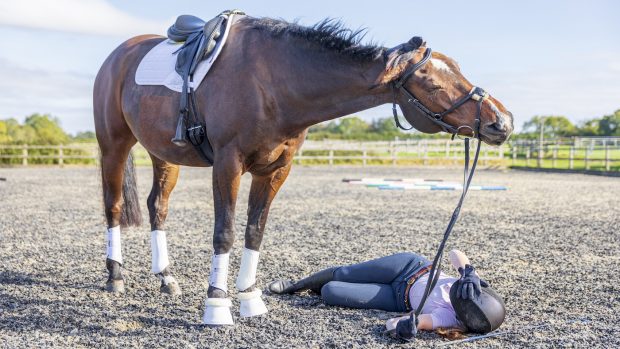A horse’s natural response to fear or pain also involves the release of a number of hormones into the blood, such as adrenaline, corticosteroids and endorphins.
These are all naturally occurring painkillers and do give the animal some relief, albeit temporary. The response also causes a very high heart rate, and the horsemay tremble and sweat.
A horse with acute severe colic, which rolls so violently it injures itself elsewhere, and seems to be unaware of these new injuries, provides a dramatic example of a violent response to pain.
Another example of the horse’s hormonal response temporarily anaesthetising the effects of pain is a horse severely injuring its leg in a race but keeping going. It doesn’t start to show the signs of pain (trembling, sweating and a refusal to take weight on the leg) until it has pulled up.
In these cases, there is little doubt that the animal is in severe pain, and the site of damage is usually (but not always) obvious.
If the painful area is more generalised, deciding what actually hurts becomes more difficult, as the horse can no longer, easily, “favour” the damaged site.
Examples include acute laminitis and muscle damage caused by azoturia; in both these cases the only protective mechanism is for the horse to remain still, or even lie down.
The signs of pain
The objective signs of elevated pulse rates, trembling and sweating, will be present, although they are indicative of “shock” as well as of pain.
The degree of response does not necessarily correspond to the degree of tissue damage or pain, and a violent reaction may be successful in removing the cause.
Horses also react violently in anticipation of pain. Most vets encounter horses that have undergone a lot of treatment previously and have become ‘needle shy’.
When the horse has been in pain for a long time (chronic pain), it no longer responds violently, and it becomes much more difficult for people (ownersor vets) to assess the real degree of suffering.
By this stage, there are no objective signs; heart rates are normal and the horse does not sweat. He will try to reduce pain by his stance; for example favouring a painful limb, or “goingshort”, with his head raised and ears back, if both forelimbs are affected.
Often, chronic pain is the result of arthritic lesions in a number of different sites, and it is impossible for the horse to favour all.
One of the best methods of judging the degree of pain is the response of a horse to painkillers such as ‘bute’, or its modern counterparts.
Where applicable, a vet may also use nerve and joint blocks with local anaesthetics to pinpoint the site of pain.
How horses respond to pain
- A horse’s hormonal response to sudden acute pain shows itself as an increased heart rate, trembling, sweating and, if possible, flight.
- Repeated infliction of pain (eg, ‘needle fear’) will provoke a ‘fight’ response.
- The degree of response does not necessarily correspond to the degree of tissue damage or pain.
- Certain physiological problems cause a horse to assume a typical pain attitude – for example the typical stance of an acute laminitic to relieve the pain in his feet.
- Chronic pain will cause a horse to favour the area of pain and make its cause harder to detect.
- Evidence of acute pain is a signal to call your vet immediately.
- Horses in shock from pain caused by illness or injury should be kept warm and as tranquil as possible. Don’t add to his distress by panicking.
- Never be tempted to give your horse that odd sachet ofbute you have in the tack room. It will mask the symptoms and make veterinary diagnosis more difficult.
- Long-term pain has a ‘wind up’ effect, making a horse more pain sensitive.
- While horses don’t smile or frown as we do, we can learn to recognise signs of physical unease or distress, both when we ride and in the stable.
- Individual horses, like individual people, have different levels of tolerance to pain.
Readmore veterinary advice:



